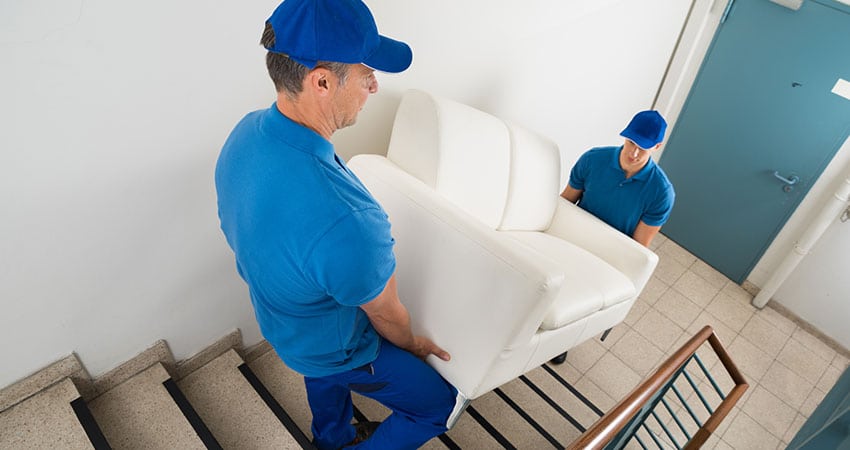Online sales of big, bulky items are exploding. Shopify estimates that global ecommerce revenue for the furniture and appliance sector alone will grow to $394 billion by 2022, up from $258 billion in 2018.
Buying a washing machine, a bed or a dining room table online is increasingly becoming an everyday thing for consumers.
But in-home delivery, which involves two-man teams and sometimes assembly of the item, are anything but routine. The problem for big-item merchants is that buyers’ expectations for fast, time-defined delivery of online purchases, with full visibility throughout, is now extending to these more difficult in-home deliveries.
Buyers used to ask retailers when their item could be delivered. Now, they want to choose the in-home delivery time and track it online. That’s a somewhat new and difficult expectation for brands to meet, especially when managing hundreds of trucks using relatively manual, often paper-based processes.
The good news is that sophisticated truck routing solutions are available to help merchants better manage in-home home delivery operations and meet consumers’ expectations. Here are five primary benefits big-item buyers want from a delivery experience, and how merchants can achieve them.
Choose the Delivery Time Slot
Whether shopping at home or in store, consumers want to pick the date and time of delivery. Choice is critical, but if retailers offered unlimited options, delivery fleets could be driving up to 30% more miles than necessary. For a fleet of 100 trucks, each running an average of 50,000 miles per year, that 30% equates to more than $9 million in added annual costs, based on cost-per-truck-mile data from the American Transportation Research Institute.
Routing software, integrated with the checkout process of your ecommerce platform, can enable controlled choice. Once buyers enter a ZIP code to schedule a delivery, they can be directed toward the most cost-efficient slots, such as a morning when a delivery is already planned for the same ZIP. Available delivery slots change in real time as new orders are added, and the software lets you score and display slots based on how cost-effective or green-friendly they are.
Change the Delivery Time
Consumers prefer to buy from brands that can easily accommodate schedule changes. And they prefer to manage the changes themselves online and whenever they want. That’s no problem with the right software, which can manage change requests using the same controlled choice process as the original booking.
By giving customers the ability to manage changes, brands maximize first-time delivery success rates and avoid the unwanted costs of redelivery. One large garden supply retailer reduced failed deliveries by 33% after enabling the self-service feature of its home delivery software, resulting in a six-figure savings.
Receive Reliable ETAs
“We’ll be there between 12 p.m. and 8 p.m.” is no longer an acceptable delivery promise. Consumers want to be unchained from the constraints of a vast in-home delivery window, fitting much tighter timeframes into their daily schedule.
With the right route optimization solution, merchants can offer this high degree of delivery-time certainty. Delivery route timing is impacted by dozens of factors, from average road speeds to unloading times per drop, to truck and driver availability. Routing system algorithms account for all these variables and can predict highly accurate ETAs, even if it’s the 12th delivery of the day.
Get Proactive Notifications
Today’s tech-savvy consumer expects proactive alerts on shipment progress right up to the time of in-home delivery. Email or text/SMS ETA updates can be scheduled as often as you like, and automatic day-of-delivery updates from the driver can alert consumers on the expected arrival time, such as “On our way. See you in 30 minutes.”
Having a single system that provides visibility across the different activities in your organization enables you to identify exceptions and proactively respond. For example, a delay at the fulfillment center can trigger an early notice to the customer of a schedule change.
Check Delivery Status Online
When it comes to delivery status updates, consumers prefer the self-service option. Yet brands continue to pay $7 to $13 per interaction for customer service representatives (CSRs) to field status inquiries all day long. In our experience, it’s possible to eliminate a large percentage of these costs by integrating live order tracking into your customer web portal, a step that pays for itself almost immediately.
In this digital age, failure to enable customer self-service can diminish not only your profit but also your brand. One smaller retailer recently told us that, for drivers without cell phones, the company’s CSRs often call the customer to ask, “Has our driver shown up yet?” Not exactly the best way to establish your reputation as a modern, efficient or digital-savvy brand.
Winning Sales Through Superior Home Delivery
Today’s consumers expect a fast, seamless and largely online home delivery experience, even for big, bulky items. Brands that are not ready for this era of consumer-driven delivery service will either lose customers to better-prepared competitors, or cannibalize profits by trying to meet enhanced service demands using systems ill-equipped for the job.
With the coronavirus pandemic increasing home delivery more than ever, trucking operations that used to operate in the shadows must now take center stage. Selecting the right technology to power your fleet means home delivery can actually become the cornerstone of your value proposition.
It’s time to stop thinking of your in-home delivery operation as that invisible, back-end function that completes a sales process, and start thinking of it as the very thing that triggers a sale.
Manog Tseung is a Product Manager at Paragon Software Systems, a subsidiary of Aptean

